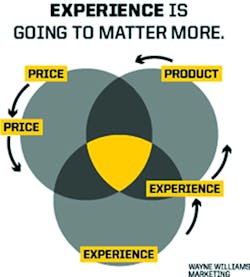Like I’ve said before, I read a lot. Every day I receive emails that offer interesting and fact-filled information gleaned from recent studies. There is no shortage of findings and opinions about the importance of giving improved attention to the customer experience.
From time to time I secretly say to myself, in the privacy of my own mind, “I’m tired of bending over backwards. When are customers going to appreciate the extra effort?” Sometimes I say to myself, “Who cares about studies? Who cares about customer service? Who are these people anyway? They’ve never sold a tire in their life.” Usually, however, I quickly snap out of it because I know true customer service is more than a mantra or a mission statement. It’s the lifeblood of any customer-facing organization.
That being said, I just finished reading a 24-page report on the UX Revolution. Do you know what “UX” stands for? UX stands for “User Experience,” and simply stated, it’s the customer’s experience when using a website, a customer’s online experience.
In past articles, we’ve discussed the fact that more and more consumers search the internet for pre-purchase information. It’s generally understood today that 80% of tire shoppers do initial research online. Of course, online is pre-personal contact, pre-phone, and pre-visit. The article made clear the importance of a good UX experience and how that might influence a call or visit.
Having said that, every tire dealer has a product, a price and an experience. The big winners today and in the future will be the dealers that deliver on all three: price, product, and experience. The shift is taking place now. Consumers today decide what to buy and then where to buy it.Let me give you a simple example. I don’t like to buy Starbucks coffee; I like to drink it. My wife, on the other hand, digs the whole experience. While standing in line, she likes to fiddle with the mugs, you know, the $5 mugs that sell for $10.95. She likes to grab an extra bag of Decaf Caffe’ Verona or Mocha Flavored Coffee, you know, just in case.
Though we are standing side-by-side at the same Starbucks, at the same time, we are experiencing the store differently.
In downtown Orange, Calif., founded in 1869, my wife and I enjoy visiting our favorite antique shops. In the middle of the downtown plaza, there are two Starbucks locations directly across from each other, not more than 100 yards apart. I always choose one over the other. Why? One has better parking behind the store (easier egress), the layout of the store is nicer, and the rest rooms are bigger and cleaner. The products are the same, the prices are the same; however, the experience is not just different, but better in my mind.
Consumers will typically choose one location over another depending on a variety of personal preferences. The tire dealership that meets their needs, their preferences, their individual feelings will win the sale. Because we don’t know which category is more important at any given moment, we need to be competitive in all three areas. According to the article, a consumer’s experience is going to be more important than price and product by the year 2020.
At first I say, “How do they know that? Is this even possible? Isn’t price always number one?” As I thought about this prediction, I remembered a veteran salesman asked me one time, “Do you make money when you sell to your friends or enemies?” The answer is easy; your enemies don’t buy from you. It’s the same with experience, like rock-paper-scissors, bad experiences outweigh price and product. It’s very hard to sell around a bad reputation built on bad experiences, even if your prices and products are right.
Another example, there is an Italian restaurant near my home, very convenient. The price is good, the food is good, and the experience is not. I no longer go there. As I read the article and pondered it, I realized that this is not new news; it’s always been a combination of price, product and service. What struck me was the shift toward the increased important of experience.
Look at the illustration. This is important for us to consider if, in fact, this shift is happening, and there is plenty of evidence to support such. A simple 180 degree turn in either direction puts experience on top. The sweet spot is the center where it all intersects. ■
Wayne Williams is president of ExSell Marketing Inc., a “counter intelligence” firm based in La Habra, Calif. He can be reached at [email protected].
To read more Counter Intelligence columns, see:
At the Sales Counter: Focus on Feelings Supported by Facts
The Sales Counter Moved Again: And the Sales Floor is Now on the Smartphone
The Changing Language of the Marketplace
'Better' Pays Dividends: You Better Be Better Onbline and In Your Store


